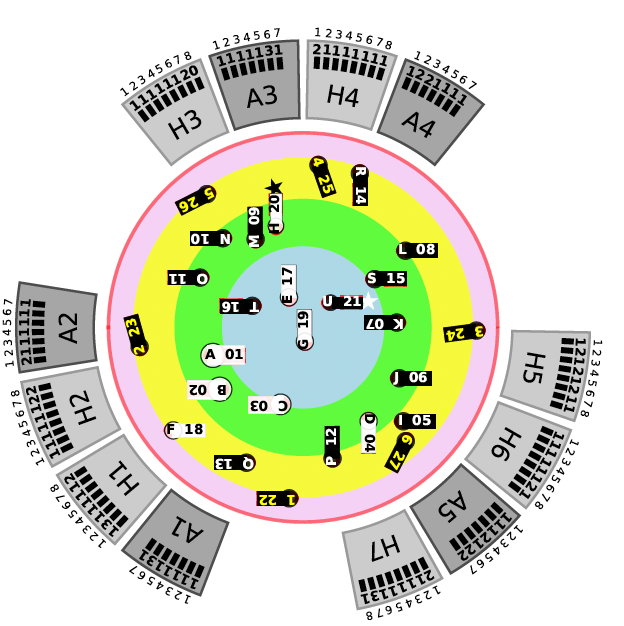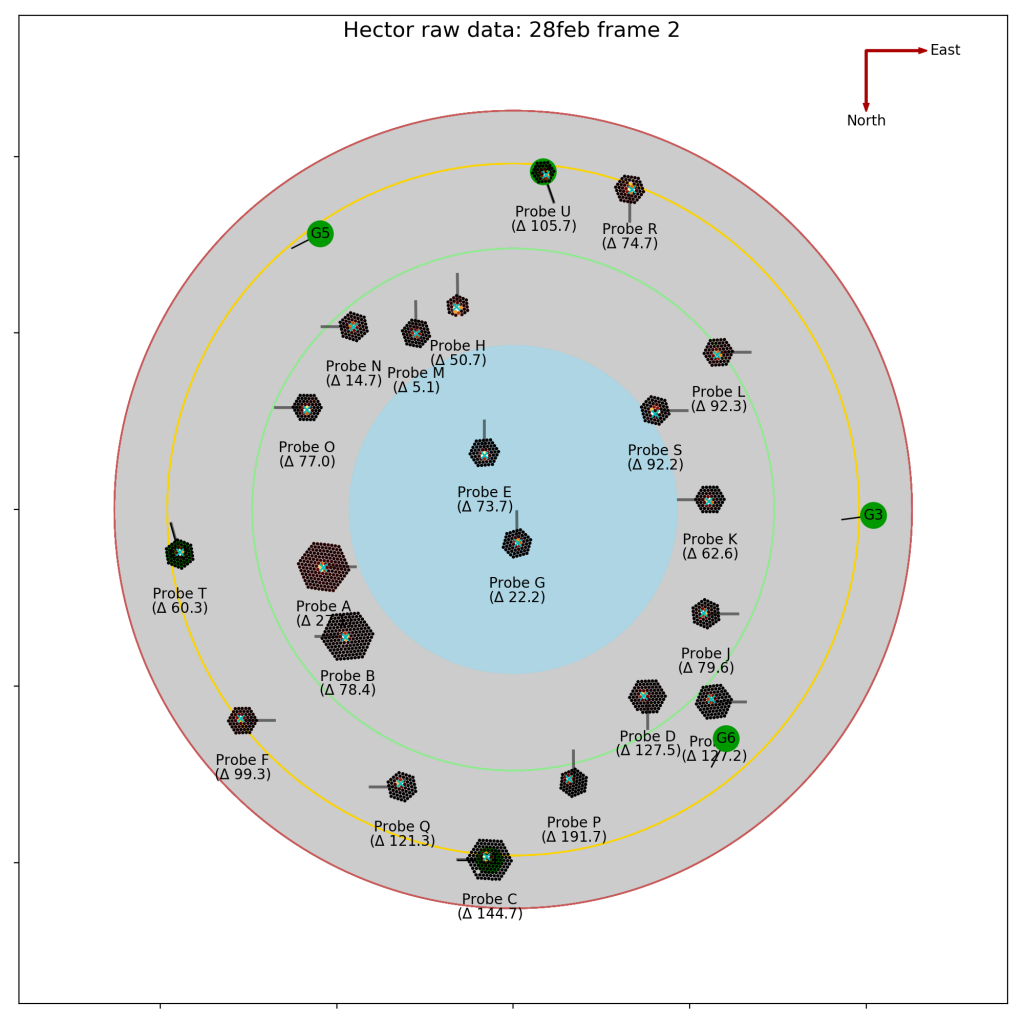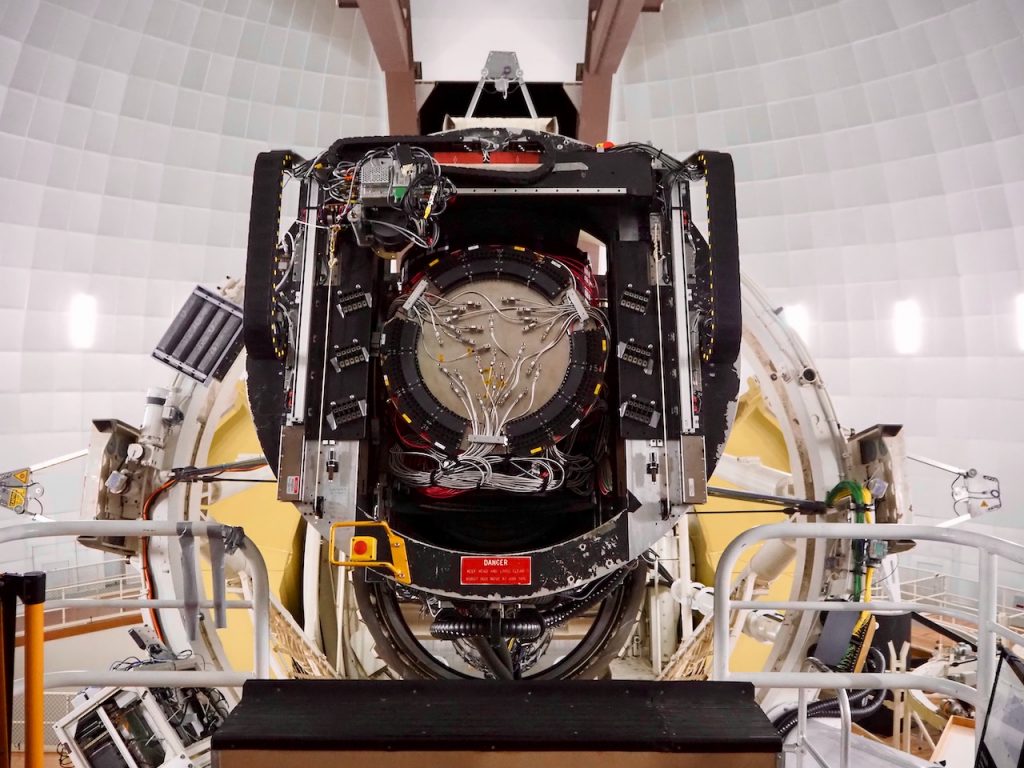On this page there are reports of the commissioning status for each run. For more details, you can check the log files. For more fun, you can check the Hector Photo Album: pictures of Hector on the AAT and videos of the robot!
Run 3: February 2022
Overall, we are very happy with what we have achieved in this run, even though the weather was mostly cloudy. There were no nights in which we could have observed galaxies, but there were three nights where we could (on and off) look at our bright star fields through cloud, for the alignment tests. We were flat out for all of the cloudy nights and we ticked a lot of boxes:
- Implemented the positioner calibration that were previously inaccessible in Labview into python along with the metrology. This allowed us to make multiple improvements and checks and identify further improvements that will be made in the coming weeks.
- Trained 4 fantastic team members for plate plugging and running the robotic positioning system.
- Debugged a bunch of positioning calibrations and, as previously reported, solved the large positioning offset that had hampered us before.
- Tested the new improved field plate rotator and found it to be much improved, but perhaps not yet perfect, and the data will allow us to quantify that in the coming week or two.
- Tested data reduction and throughputs, and took a lot of calibration data which still needs further analysis.
- Debugged dome flat alignment issues with the screen. Tested the newly painted dome flat screen. Characterised the new dome flat lamps and gave feedback to the observatory on what is required to make them spatially and spectrally flat enough for Hector.
- Implemented multiple improvements to the robot positioning to correct a few software bugs, improve stability, and reliability. The robot ran in its automatic mode all of this run (rather than the manual mode used in the previous 2 runs). There are a few small tweeks still needed that are associated with errors introduced by a microsoft update of the robot pc, which should have been blocked and somehow wasn’t. Site is looking at that, since it is controlled by the site network updates. However, as a positioner, the robot is now working well with regard to its precision and successfully running automatically – quite beautiful to watch – we loaded and unloaded 8 full fields without robot issues. Remaining issues are essentially microsoft(!).
- Took calibration data needed to test the “medium” speed mode of the Spector spectrograph. The “normal” mode has a very slow readout of about 5 minutes, but the medium is about 1 minute, which would be great if the image specs are ok. Data is in the process of being analysed.
- Multiple changes and new implementations of software for the control system, such as automatic focussing routine for the new spectrograph.
- Improved and sped up the plate plugging procedure using a different approach to cable wrapping compared to the previous two runs.
- Calibrated the thermal expansion of the robot as it behaves in the dome (which helps to improve our positioning).
- Debugged a thousand little things along the way.



With so little on-sky time in the 2 weeks, we have however some commissioning tasks still remaining that will need to be done in the May run before we move onto galaxies. Those include measuring the “P” and “Q” values for the hexabundles, checking the optical model effects on P and Q, implementing code for the robot pick up arm decenter and for improvements to the metrology rotations, implementing an updated fit to the optical distortion model (for the alignment of Hector to the telescope optics). All of those have some data taken in this run but need to either be analysed and implemented, or require more data to be completed next run.
One downside in this run was that a prism came off one of the hexabundles. We were a bit devasted by that, since aligning and adhering the prisms in Hector was one of the most challenging parts of the build. This will however be replaceable, but not on a short timescale, so that hexabundle will be temporarily out of service until it is re-prismed.
Run 2: January 2022
The main aim for this run is to understand and measure the offsets in the positions of the galaxies in the bundles to calibrate all of the effects that contribute to centring in the hexabundles. We are using star fields to do this, rather than observing galaxies for now.
Run 1: Dec 2021
In summary, from the first commissioning run:
- Galaxies in all hexabundles – and yes, that is simultaneously 🙂. They are quite well centred (but not yet perfectly) . The moment the first galaxy field was reading out and we were waiting to detect out first WELG as the detector read out, was captured in this video https://youtu.be/VFYlC0DUYpc (WELG = wiggly emission line galaxy).
- Stars in all hexabundles and guide bundles.
- A guider that is guiding and centring with a few more changes to software required.
- Sky fibre system with subplates and piston that are performing nicely to spec.
- Magnetic field system which does its job nicely (in 3D to correct for telecentricity).
- The Spector Spectrograph with very much higher throughput in the blue than we had for SAMI and the higher spectral resolution as promised. Minor modifications only needed to the software, and the red camera is having some issues that the manufacturer should be able to fix.
- Fibre system that is mostly doing its job, but with more analysis on throughput yet to be done.
- Below you can download the log.
Things to work on the next commissioning runs:
- Fixes to some software issues with the robot positioner.
- Changes to the plate rotator to improve centring in the field.
- Implementation of distortion corrections and offsets to improve the centring across the field.
- Further streamlining of plate changes (although they are going rather ok already but we haven’t changed enough plates yet to have refined this).
- Further improvements in data reduction and characterisation of performance.
- …a bunch of other smaller stocking fillers.


